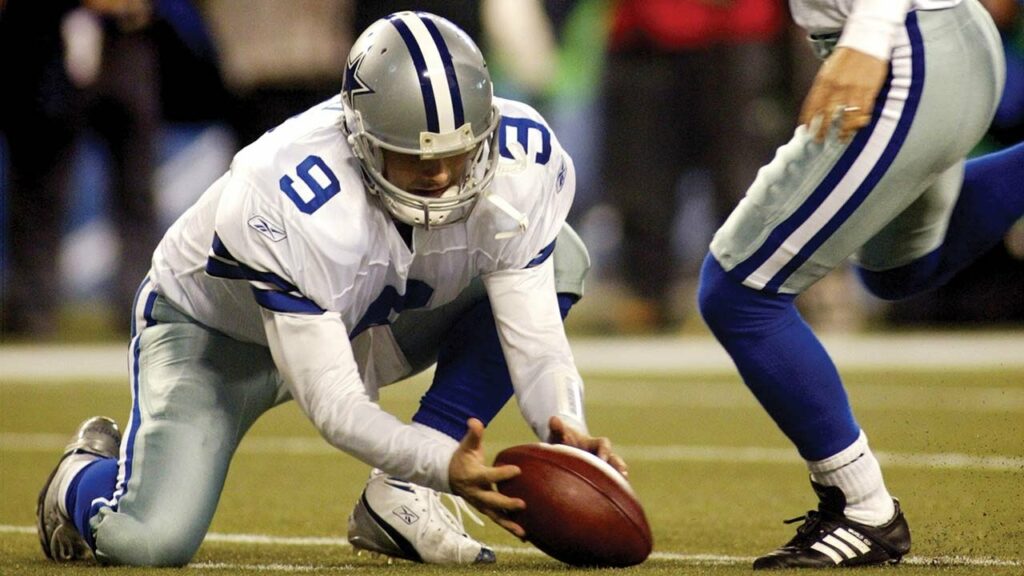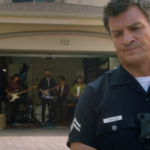
FOOTBALL LEGEND: Tony Romo’s fumbled hold in the 2006 NFC Wild Card game led to a new rule about the footballs used for kicks in the games.
Tony Romo had a fine NFL career as the Dallas Cowboys quarterback, and he is currently one of the most popular TV announcers in all of football, so things have worked out well for him in life. However, I’m sure he’s still a bit haunted by his very first playoff start in the 2006 NFC Wild Card Game (Romo had only taken over as the Cowboys QB from veteran Drew Bledsoe in the middle of Week 7 of the 2006 season). Since Romo was the backup to start the season, he served as the holder for the Cowboys on field goal attempts and despite becoming the starter, he remained in that role of the holder.
Well, with the Cowboys about to kick an easy field goal to give themselves the lead with less than two minutes left in the NFC Wild Card game, Romo muffed the hold, and the field goal could not be attempted. Romo smartly tried to then run the football for a first down (or even a touchdown), but he was tackled just shy of the first down.
Brutal stuff.
However, interestingly enough, the play ended up changing the rules in the NFL for how kicking balls were handled from that point forward.
By the 1998 National Football League (NFL) season, teams had shared balls that were used for both offense and for kicking. Well, kickers began to doctor the ball like crazy to give themselves a competitive advantage when it came time to take kicks. Their only real limit was whether their changes irritated their quarterback. In 1994, the NFL announced that it would fine anyone who doctored a ball, and kickers laid off for a bit, but when it was clear that no one cared, the kickers went right back to it.
It is unclear exactly what led to the change following the 1998 season, but most kickers agree that it was Minnesota Vikings punter Mitch Berger and his placekicker teammate, Gary Anderson, who spoiled the fun for everybody. Berger recalled being told, “You can do whatever you want to [the footballs] as long as Randall Cunningham likes throwing them,” so he and Anderson did all sorts of weird stuff, to the point where the balls were basically like rugby balls.
After Anderson didn’t miss a single field goal that year and Berger set a record for the most touchbacks by a punter, the NFL Rules Committee introduced the idea of “Kicking Balls.” Each game would have twelve balls designed specifically for kicking, six to each team, and they would rotate throughout the game.
Longtime NFL punter (also, amusingly enough, a Viking) Chris Kluwe recalled the problem 10 years ago:
When they first come out of the plastic bag, yes they are absolutely awful. They’re super hard, have this nasty ball grease on them that makes them slippery, and usually the seams are protruding a bit so they’re more square than round. They’re terrible.
Now here’s some fun behind the scenes info most people don’t know. The quarterback balls are allowed to be worked in a week prior to the game because no one wants to see them flailing around out on the field; apparently that’s bad television. The kicking balls though? Up until 3 years ago you had 15 minutes before the game started to try to break in 12 kicking balls to something resembling an oblong.
The problem in the Cowboys/Seahawks game was that the ball that had come up in rotation by the end of the game was a ball that had not been treated much at all, and so it was essentially covered in grease, so Romo had a legitimate beef with the condition of the ball when he received the snap.
So the NFL changed the rule, and since then, teams have had FORTY-FIVE minutes to prepare the balls, and as time has passed, the balls have also reduced from 12 (six per team) to 6 (three per team), so it’s even easier to get the balls brushed into good shape.
You’re only allowed water and a specific type of brush (teams have legit gotten into trouble for using the wrong brush handle), but a good equipment manager is able to get them into good shape.
And all because of a disappointing moment in Tony Romo’s acclaimed career.
The legend is…
STATUS: True
Be sure to check out Sports Legends Revealed for more urban legends about the world of sports. Here is the archie for just legends about football.
Feel free (heck, I implore you!) to write in with your suggestions for future installments! My e-mail address is bcronin@legendsrevealed.com.









